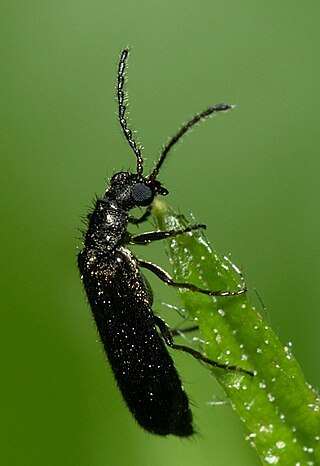
Secotioid fungi are an intermediate growth form between mushroom-like hymenomycetes and closed bag-shaped gasteromycetes, where an evolutionary process of gasteromycetation has started but not run to completion. Secotioid fungi may or may not have opening caps, but in any case they often lack the vertical geotropic orientation of the hymenophore needed to allow the spores to be dispersed by wind, and the basidiospores are not forcibly discharged or otherwise prevented from being dispersed —note—some mycologists do not consider a species to be secotioid unless it has lost ballistospory.

The Dark Divide is the largest roadless area in western Washington state, comprising approximately 76,000 acres (310 km2) of intact wilderness on Juniper Ridge linking Mount St. Helens and Mount Adams in the southern Cascade Mountains of Washington. In two remote valleys of the Lewis River drainage are 500-year-old trees. These ancient forests are protected from logging as reserves for the northern spotted owl and other species under the Northwest Forest Plan.

The Hymenogastraceae is a family of fungi in the order Agaricales with both agaric and false-truffle shaped fruitbodies. Formerly, prior to molecular analyses, the family was restricted to the false-truffle genera. The mushroom genus Psilocybe in the Hymenogastraceae is now restricted to the hallucinogenic species while nonhallucinogenic former species are largely in the genus Deconica classified in the Strophariaceae.

Dasytes is a genus of beetles in the family Melyridae.

Hygrophorus subalpinus, commonly known as the subalpine waxycap, is a species of white snowbank fungus in the family Hygrophoraceae. Found in the mountains of western North America, it is found growing on the ground under conifers, usually near snowbanks.

Boletus regineus, commonly known as the queen bolete, is an edible and highly regarded fungus of the genus Boletus that inhabits southwestern North America. It was considered a variant of the similarly edible B. edulis for many years until declared a unique species in 2008. Phylogenetic analysis has shown B. regineus as a member of a clade, or closely related group, with B. subcaerulescens, Gastroboletus subalpinus, B. pinophilus, B. fibrillosus, and B. rex-veris.

Hymenogaster is a genus of fungi in the family Hymenogastraceae (Agaricales). The genus has a widespread distribution, especially in temperate regions, and contains about 100 species. The taxonomy of the European species was revised in 2011, and twelve species were recognized, for which an identification key was presented.
Descomyces is a genus of fungus in the family Cortinariaceae. The genus contains five species formerly restricted to Australasia, but now more widespread due to having been spread with Eucalyptus. Descomyces was described in 1993 by mycologists Neale Bougher and Michael A. Castellano.
Quadrispora is a genus of fungi in the family Cortinariaceae.

Boletus fibrillosus is a basidiomycete fungus of the genus Boletus found in western North America. The fruiting bodies are found in mixed coastal forests in the fall, usually singly or in small groups. The cap is up to 17 cm wide, buff to brown to dark brown in color, and has a wrinkled to finely fibrous texture. The tubes are yellow, while the flesh is white to buff and does not stain when cut. The stem is yellowish at the top, brown otherwise, with a reticulate texture, and mycelium enshrouding the bottom. The holotype was collected in Mendocino County, California. The species is edible, but considered to have inferior taste to other edible boletes such as B. edulis, which it is often confused with.

Boletus subalpinus is a species of fungus in the family Boletaceae. The species was first described scientifically in 1969 by American mycologists Harry Delbert Thiers and James M. Trappe. It is found in California and Oregon. It was originally named as a species of Gastroboletus but was found to be in Boletus sensu stricto in a 2013 molecular phylogenetics study.
Dolianthus is a genus of flowering plants in the family Rubiaceae. The genus is endemic to New Guinea.

Calochortus subalpinus, the subalpine mariposa lily, is a North American species of flowering plants in the lily family native to the northwestern United States.
Joan Winifred Cribb was an Australian botanist and mycologist.
Destuntzia rubra is a species of truffle-like fungus in the family Gomphaceae, and the type species of the genus Destuntzia. The fungus was first described scientifically in 1899 by H. W. Harkness as Hymenogaster ruber. Robert Fogel and James Trappe transferred it to Destuntzia in 1985.
Onychembolus is a genus of South American dwarf spiders that was first described by Alfred Frank Millidge in 1985.
Tmesisternus subalpinus is a species of beetle in the family Cerambycidae. It was described by Gressitt in 1984.
Alpinoscincus subalpinus is a species of skink found in Papua New Guinea.
Alpinoscincus is a genus of skinks in the subfamily Eugongylinae. The genus Alpinoscincus is endemic to New Guinea.
This page is based on this
Wikipedia article Text is available under the
CC BY-SA 4.0 license; additional terms may apply.
Images, videos and audio are available under their respective licenses.








